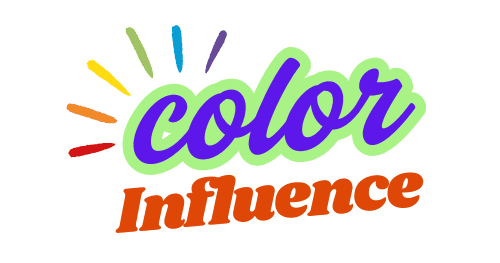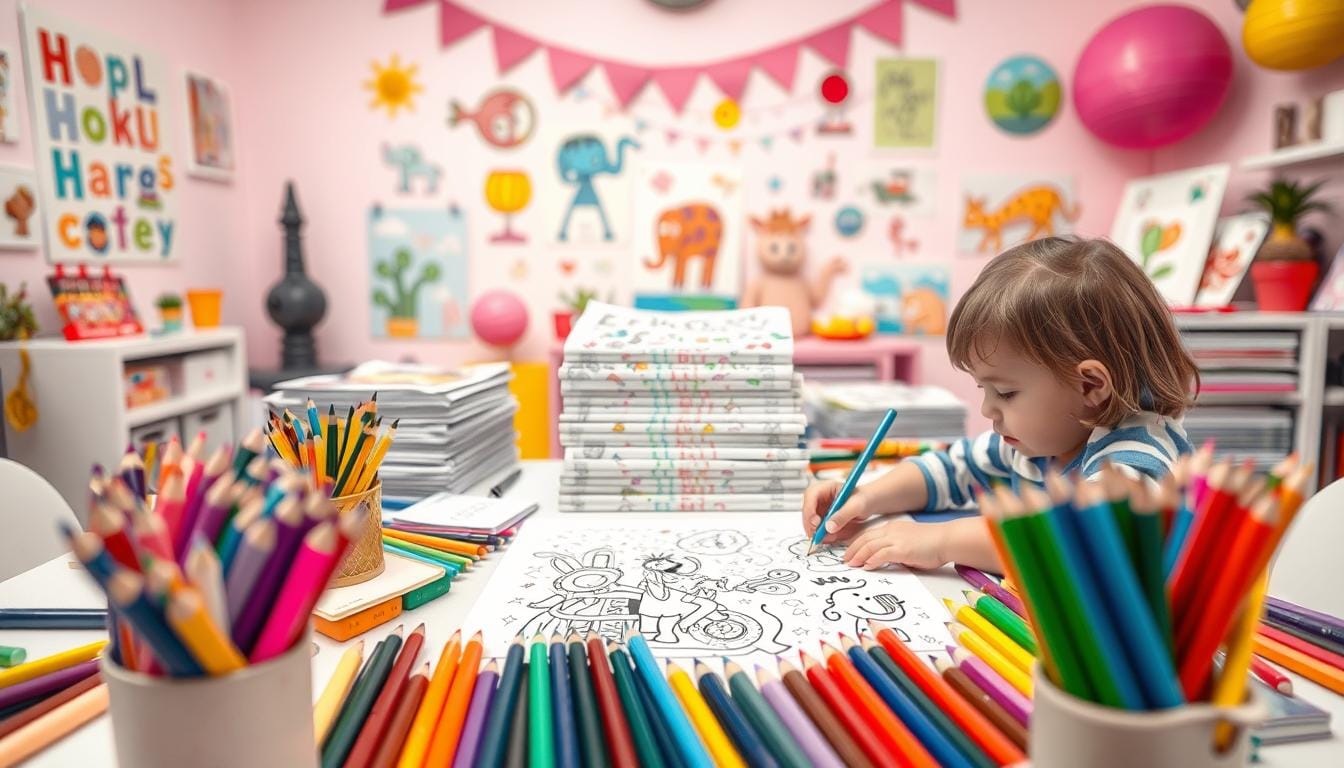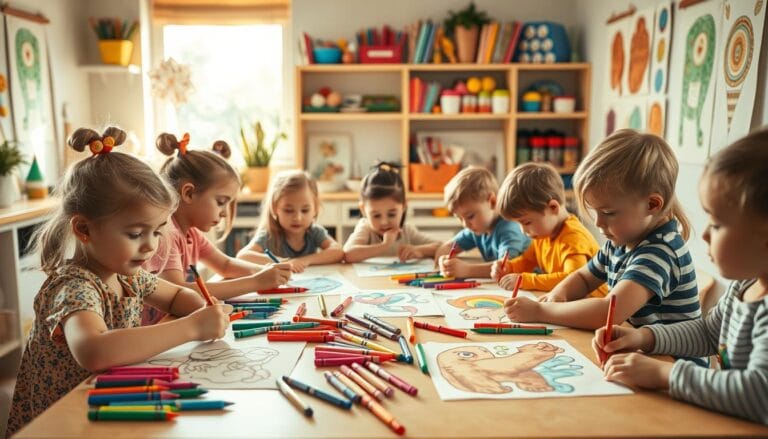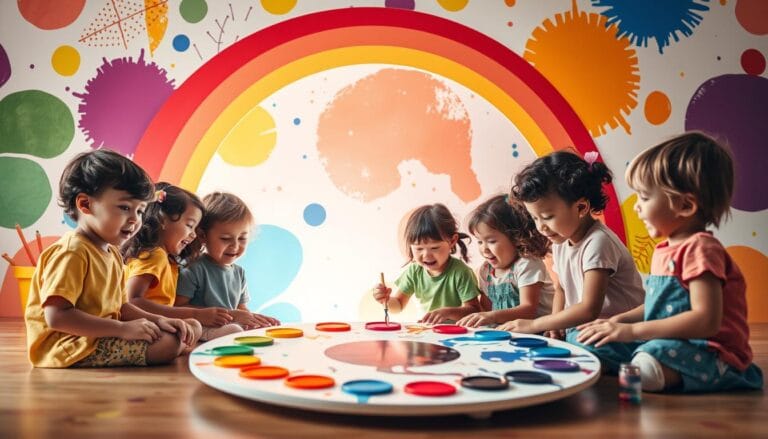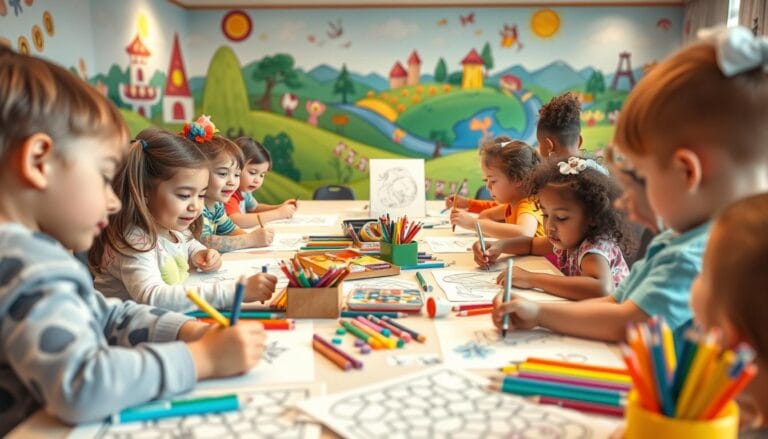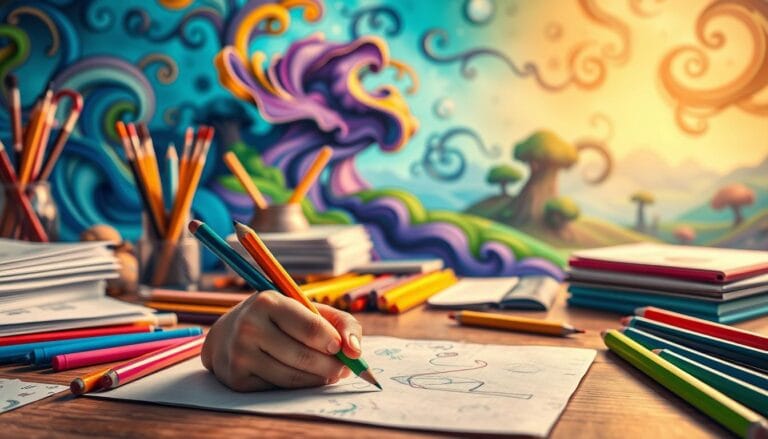Unlock Your Child’s Imagination with These Coloring Activities
Every crayon stroke opens a world of endless possibilities. Coloring is more than just a fun activity. It’s a powerful way to help your child grow creatively and develop important skills. From toddlers to school-age kids, these activities can turn a regular day into an exciting adventure of learning and discovery.
Picture your child’s face lighting up as they play with colors and shapes. Coloring is not just fun. It’s a key way to help your child grow in many areas, like thinking, feeling, and using their hands.
Coloring gives kids a special place to be themselves, without fear of being wrong. They can draw anything they want, from superheroes to animals. Each picture is a chance for them to learn and get better at something new.
Understanding the Power of Creative Expression Through Coloring
Coloring is more than a fun activity for kids. It’s a powerful tool for emotional growth and self-discovery. Art therapy and color psychology show how creative expression can open a child’s inner world. It supports their psychological growth.
Creative activities offer a special way for kids to explore and share their feelings. Through coloring, they can:
- Express emotions they might struggle to say out loud
- Develop emotional intelligence
- Build self-confidence
- Learn to understand their inner experiences
The Psychology Behind Children’s Art
Every color stroke tells a story. Kids use art as a natural way to express emotions. Color psychology says different colors can show various emotional states. Bright colors might show happiness, while darker shades might show more complex feelings.
How Color Influences Emotional Development
Colors are key in a child’s emotional world. By playing with different colors, kids learn to recognize, process, and share their feelings. Art therapy shows that color choices can reveal a child’s emotional state.
Building Confidence Through Artistic Achievement
Finishing a coloring project makes kids feel accomplished. This small win boosts their self-esteem and encourages more creativity. By embracing their unique artistic expression, kids grow resilient and confident.
Essential Benefits of Regular Coloring Activities
Coloring is more than just a fun activity for kids. It’s a powerful tool for growth that brings many benefits. It helps kids in many ways, making it valuable for parents and caregivers to understand.
Let’s look at the main benefits of coloring:
- Cognitive Development: Coloring boosts problem-solving and creativity by working both brain sides.
- Emotional Regulation: It helps kids express feelings through color, leading to stress relief.
- Motor Skill Enhancement: It improves hand-eye coordination through precise coloring.
- Concentration Boost: It helps kids focus, improving their ability to stay attentive.
Studies show that 20 minutes of coloring can lower anxiety. Kids who color regularly get better at recognizing colors, solving spatial problems, and expressing emotions. They also become more patient, make better decisions, and feel more confident.
Coloring is more than just adding color to a page. It’s a way to support your child’s growth in many ways. By encouraging coloring, you give them a fun, therapeutic experience that helps them grow.
Coloring is a gateway to imagination, learning, and emotional well-being.
Developing Fine Motor Skills Through Art
Coloring is more than fun for kids. It’s a way to build important fine motor skills. These skills help with hand strength, coordination, and precision. They are key for learning and everyday tasks.
Art activities help kids improve their physical abilities. Through coloring, they learn to write and draw better. It prepares them for complex hand movements.
Proper Grip Techniques for Different Age Groups
It’s important to know the right grip for each age. Here’s how grip changes as kids grow:
- Toddlers (1-3 years): Palmer grasp – holding crayon with entire hand
- Preschoolers (3-5 years): Transitioning to pincer grip – using thumb and forefinger
- Early Elementary (5-7 years): Developing mature tripod grip for precise control
Progressive Skill Development Stages
| Age Group | Motor Skill Development | Recommended Activities |
|---|---|---|
| 1-2 years | Basic hand movements | Large crayon scribbling |
| 3-4 years | Increased hand control | Shape tracing, color recognition |
| 5-6 years | Precision and detail | Detailed coloring, staying within lines |
Handwriting Enhancement Through Coloring
Coloring helps improve handwriting. It builds muscle strength and coordination. This is essential for clear, confident writing.
Try different coloring techniques to challenge your child. Each stroke and color choice helps develop important physical abilities. These skills support their learning journey.
Digital vs Traditional Coloring: Finding the Right Balance
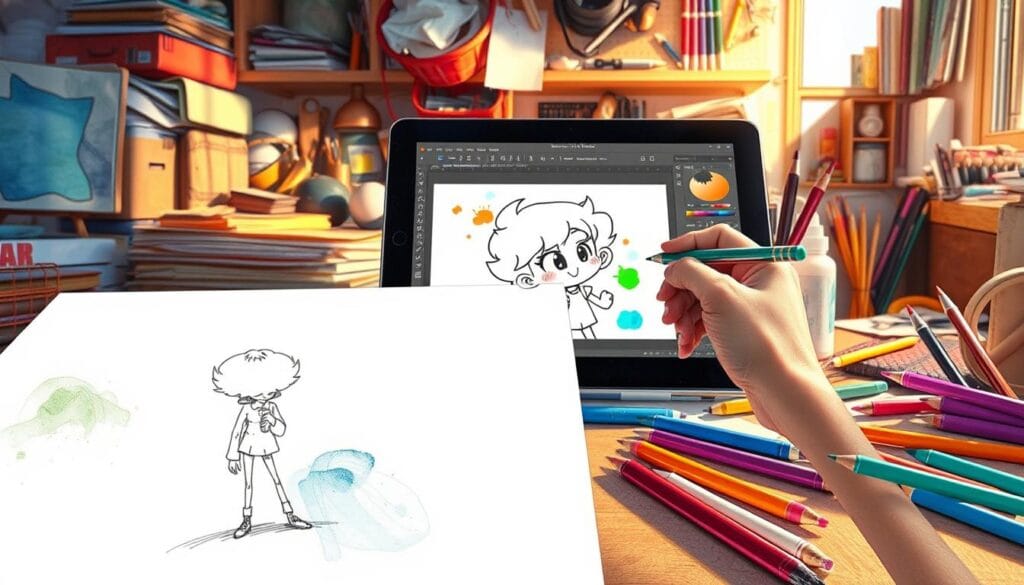
Choosing between digital and traditional coloring for kids is important. Digital coloring is easy and convenient. But, traditional coloring books offer a real, hands-on experience that boosts creativity.
Research shows the value of mixing digital and non-digital activities:
- 78% of students like having both digital and non-digital coloring options
- 45% of classrooms have media-free zones to cut down on screen time
- 90% of parents think a mix of digital and traditional activities helps kids grow
Digital coloring apps like KidsColoringPage are fun and interactive. They let kids pick colors easily, make corrections, and enjoy cool effects. But, traditional coloring helps kids develop their fine motor skills and offers a sensory experience that screens can’t match.
Here are some tips for balancing digital and traditional coloring:
- Limit digital coloring to 20-30 minutes a day
- Switch between digital and traditional coloring books
- Follow the 20/20/20 rule to avoid eye strain during digital activities
The aim is to make coloring fun and beneficial for your child’s growth and creativity.
Mindfulness and Focus Through Coloring Activities
Coloring is a powerful tool for kids to develop mindfulness and handle stress. Research from the University of the West of England shows that 20 minutes of coloring boosts creative thinking and focus.
Artistic expression through coloring helps kids process emotions and find calm. The benefits of coloring go beyond just fun.
Creating Quiet Time Routines
Setting up a regular coloring time helps kids learn mindfulness. Here are some tips:
- Choose a specific time each day for coloring
- Make a quiet, cozy space without distractions
- Play soft music in the background to relax
- Encourage slow, careful coloring movements
Breathing Exercises During Coloring Sessions
Adding breathing techniques can make coloring even more relaxing. Try these easy steps:
- Teach deep belly breathing first
- Match breathing with coloring strokes
- Practice breathing in and out mindfully
- Use picking colors as a meditation
Stress Relief Techniques for Young Artists
Studies show coloring can cut stress by up to 30%. By making coloring a meditation, kids can learn to control their emotions.
A study from the University of Otago found that coloring for 10 or more minutes daily reduced symptoms of anxiety in young adults.
Encourage your child to see coloring as a way to manage feelings and find peace.
Choosing Age-Appropriate Coloring Tools and Materials
Choosing the right coloring supplies is key for your child’s art growth. Each age needs special tools and materials. These support their skills and creativity.
For toddlers aged 2-5, safety is top priority. Look for non-toxic, easy-to-grip coloring supplies. Water-based markers and large crayons are best for them.
- Choose art materials with ASTM D4236 safety certification
- Avoid products with chemical warnings
- Prioritize thick, sturdy drawing tools
Children aged 6-11 start to use more advanced coloring techniques. They can handle tools like colored pencils, thinner markers, and watercolors.
| Age Group | Recommended Coloring Supplies | Safety Considerations |
|---|---|---|
| 2-5 years | Chunky crayons, thick markers | Non-toxic, large grip |
| 6-11 years | Colored pencils, watercolors | Moderate complexity, supervised use |
| 12+ years | Fine art quality materials | Advanced techniques, minimal supervision |
“Art is a language of creativity that starts with the right tools” – Children’s Art Education Expert
For teens 12 and older, invest in top-quality art materials. Digital styluses and professional-grade colored pencils are great for advanced art.
Parents on a budget can find deals in thrift stores, online, and by buying in bulk. DIY art supplies are also a fun and affordable option.
Incorporating Educational Elements into Coloring Time
Coloring is more than just fun. It’s a way to learn and grow. By making coloring a learning experience, you can make art time exciting and educational.
To make coloring educational, you need to plan carefully. Choose coloring pages that teach important lessons. This way, kids learn while they have fun.
Color Recognition and Vocabulary Building
Coloring helps kids learn new words and colors. Use coloring pages that match their interests. This makes learning fun and easy.
- Name different color shades
- Describe object colors
- Associate colors with real-world items
Theme-Based Learning Through Art
Coloring pages can teach many subjects in a fun way. Here are some ideas:
- Nature-inspired pages showcasing animals and plants
- Historical scenes introducing cultural concepts
- Scientific illustrations explaining basic biological processes
Mathematics and Patterns in Coloring
Coloring can also teach math. It helps with recognizing patterns and shapes. Use coloring pages that teach math concepts.
| Mathematical Concept | Coloring Strategy |
|---|---|
| Number Recognition | Color-by-number pages |
| Geometric Shapes | Pattern-based coloring sheets |
| Symmetry | Mandala-style illustrations |
By making coloring educational, kids learn and have fun. The secret is to make learning feel like play.
Social and Emotional Learning Through Group Coloring Sessions
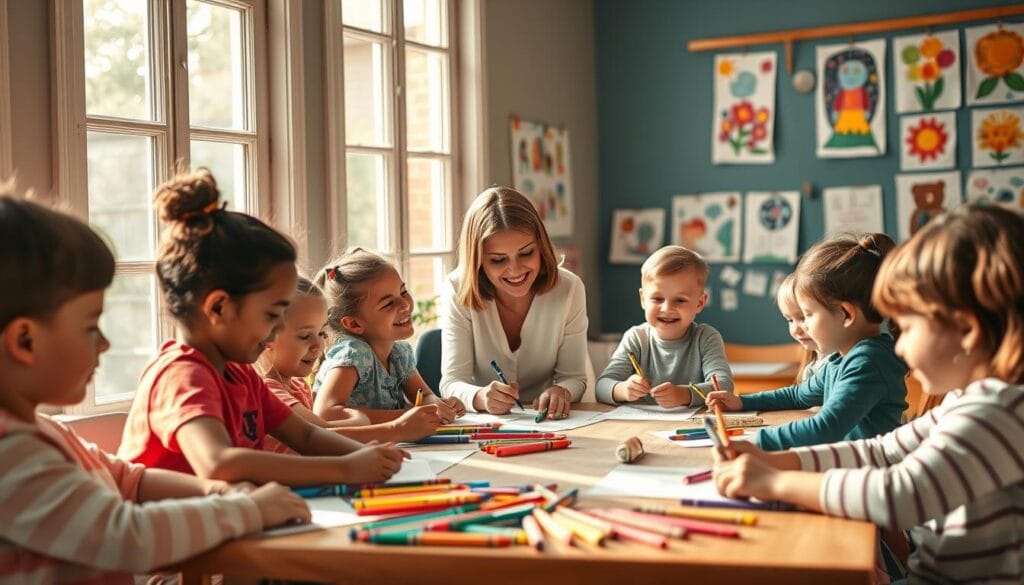
Group coloring activities are a great way for kids to learn through art. They help kids develop important social and emotional skills. These skills are not just for art, but for life.
Studies show that art therapy is very helpful for kids dealing with tough emotions. Group coloring lets kids share feelings, work together, and understand others better. It also helps them feel less stressed and anxious.
- Emotional sharing and communication
- Building cooperative skills
- Developing empathy
- Reducing anxiety and stress
In schools or at home, group coloring is a smart way to teach social skills. Children learn to share, respect others’ ideas, and express feelings through colors. It’s a safe place for them to explore their emotions without feeling forced to talk.
Creative expression through coloring helps children understand and articulate feelings they might struggle to communicate verbally.
Research shows that these activities are very important. About 4.4 million kids between 3 and 17 have anxiety. Art therapy, like group coloring, helps them become stronger, more aware of themselves, and better at making friends.
By adding art therapy to group activities, you give kids a chance to connect and learn together. Creativity is a powerful tool for growth and understanding.
Creative Projects and Art Therapy Applications
Art therapy lets kids explore their feelings through art. Parents can use color psychology to help them express emotions and develop self-expression skills.
The American Art Therapy Association says art-making changes kids. It helps them deal with feelings and grow emotionally.
Expressing Emotions Through Color
Color is key in art therapy. Each color means something different:
- Red: Represents passion and intense feelings
- Blue: Symbolizes calmness and tranquility
- Yellow: Indicates happiness and optimism
- Green: Suggests growth and healing
Building Self-Expression Skills
Art therapy helps kids talk when words are hard. Mandala coloring, for example, can calm them down and let them explore feelings safely.
Family Bonding Through Art
Make art together to bond as a family. Try these fun projects:
- Collaborative painting sessions
- Emotion color wheel creation
- Memory box crafting
- Vision board workshops
Using art therapy, you can help your child grow emotionally. Plus, you’ll have fun together.
Conclusion: Nurturing Creativity for Lifelong Learning
Coloring is more than just fun for kids. It can change how they think and learn. A study showed that art helps kids solve problems and think creatively.
Supporting coloring can really help your child grow. It makes them more independent and aware of their surroundings. It also helps them understand their feelings better. Plus, 70% of kids get better at recognizing patterns and understanding space.
Choosing creative activities means you’re preparing your child for the future. Families who color together talk more and feel closer. In fact, 75% of families say they connect better through art.
See coloring as a way to help your child grow, not just a hobby. It builds their strength, problem-solving skills, and love for learning. By doing this, you’re setting them up for success in life.
FAQ
At what age can children start coloring?
Kids can start coloring at 18 months to 2 years old. Use large, chunky crayons and thick coloring pages. These are easy to hold and use. As they get better, you can introduce more tools and activities.
How does coloring benefit my child’s development?
Coloring helps in many ways. It improves fine motor skills and hand-eye coordination. It also boosts creativity, focus, and emotional expression. Plus, it teaches color recognition and spatial awareness, and can make kids feel more confident.
Are digital coloring apps as beneficial as traditional coloring?
Both digital and traditional coloring have their perks. Digital apps are interactive and convenient. Traditional coloring is more tactile and reduces screen time. A mix of both is best, depending on your child’s age and needs.
How can I make coloring more educational?
Make coloring educational by choosing themed pages. These can teach colors, shapes, and concepts. Discuss the colors, count objects, and name animals or items. Use coloring time to learn new words and basic math.
What are the best coloring tools for different age groups?
For toddlers (1-3 years): Thick, washable crayons
For preschoolers (3-5 years): Chunky colored pencils
For school-age children (5-8 years): Standard colored pencils, markers
For older children: More precise tools like fine-tip markers or watercolor pencils
How can coloring help with my child’s emotional development?
Coloring is a safe way for kids to express their feelings. It helps them process emotions, reduce stress, and improve mindfulness. Encourage them to talk about their color choices and what they’re creating.
Can coloring help improve my child’s concentration?
Yes, coloring is great for improving focus and concentration. It requires attention, patience, and helps kids stay focused. Start with simple pages and gradually make them more complex.
How often should children color?
Aim for 15-30 minutes of coloring 3-4 times a week. This helps develop skills without getting too tired. Make it a fun, relaxed activity and avoid making it a strict routine.
Are there group coloring activities that can help social skills?
Absolutely! Group coloring can teach sharing, cooperation, and social interaction. Try collaborative art projects, coloring clubs, or family coloring time. It’s a fun way to improve these skills.
How can I encourage my child if they seem frustrated with coloring?
Focus on the process, not the result. Praise their effort, creativity, and enjoyment. Offer gentle guidance and positive reinforcement. Make coloring a fun, pressure-free activity. If they struggle, try different tools or more engaging pages.
